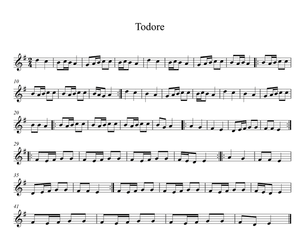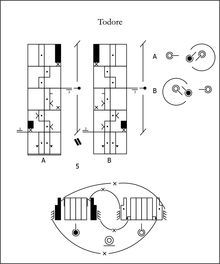TODORE
It is also called: Po jedan put drmavica or Tedu, tededu taken from one of the songs’ beginning line. Todore was a favorite dance of the carnival season but was also danced at weddings or pig slaughter. One man danced with two women on his sides. Older, good dancers often chose younger, clever girls as their partners. It has the same hold as Tanac, and the steps are equal with the second part of Tanac’s. Adjusting to the tune, the man dances first with one of the women (for the time of a quarter tune), then with the other woman, for the same length of time, but in the other direction. The waiting-woman dances the basic step but may spin as well. This basic form may change (the man turns more with one woman), lending itself to plenty of funny, playful possibilities. The skillful men “stole” another man’s “waiting” woman more than once; so, one man sometimes danced Todore with 5-6 women.
The melody is an old piper one, often with lines of differing lengths. The songs’ lyrics are funny, witticising, often dirty.
Todore is also popular among the Sokac in Baranya county. Similarities are found among the Sokac, Serbs, and Bunjevac in Bačka (Keleruj); in Slavonia (Todore, Mista); and in Srem (Todore).
The three-person dances are unique among the Hungarian Croats’, Serbs’, and our southern neighbors’ dance culture; there are only rare excepts outside the Hungarian zone. Their origin may be searched in the late medieval dance culture (which, together with other impacts, might have been passed on to different minorities by the Austrian-Hungarian Monarchy), or in the culture of the Germans living in the same area.
MUSIC
VIDEO




